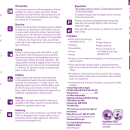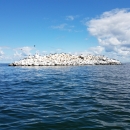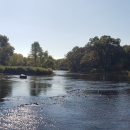America the Beautiful Passes are available at Refuge Headquarters on Wednesdays from 10am-4pm (other days and times may be available by request). Please call 763-389-3323 or email sherburne@fws.gov to schedule an appointment. For fee-based passes, we can only accept cash or check payment. To get a pass online, visit the U.S. Geological Survey Online Store.
There is no entrance fee or parking permit required to visit the refuge.
Visit Us
Sherburne National Wildlife Refuge offers people a chance to unplug and relax. Locals can enjoy regular trips to the refuge and enjoy the change of seasons. Twin Cities residents can make the short drive north for a daytrip in nearby nature. Everyone is welcome to enjoy the wide variety of activities available at the refuge. Roll down your windows on the Prairie’s Edge Wildlife Drive and look and listen for wildlife. Observe and photograph wildlife. Go fishing and hunting. Take in a program or enjoy an event. Stop in at refuge headquarters during the week to ask questions and shop at the Eagle’s Nest Nature Store for refuge gear and books.
General Refuge Information Brochure Hunting Brochure
Driving Directions
From Minneapolis and St. Paul
- Take I-94 west to the Highway 101 (Rogers) exit
- Follow Highway 101 north until it turns into Highway 169
- Follow Highway 169 north through Elk River and Zimmerman to County Road 9, an exit located four miles north of Zimmerman
- Turn left and follow County Road 9 west for four miles
- Once you see the entrance sign and information kiosk, continue west on County Road 9 to access the hiking trails, Oak Savanna Learning Center and refuge headquarters
- To access the Prairie’s Edge Wildlife Drive, take County Road 9 for 3.5 miles and take a left at the stop sign to go south on County Road 5. In two miles, take the first left to enter the Wildlife Drive.
From St. Cloud
- Take Highway 23 east through St. Cloud to Highway 95
- Follow Highway 95 east 15 miles to Mille Lacs County Road 7
- Look for the large brown information sign for Sherburne National Wildlife Refuge
- Go south 4 miles on Mille Lacs County Road 7, which becomes Sherburne County Road 5
- Once you see the entrance sign and information kiosk, continue south on County Road 5 three miles further to County Road 9
- Turn left to go east on County Road 9 to access the hiking trails, Oak Savanna Learning Center and refuge headquarters. To access the Prairie’s Edge Wildlife Drive, continue straight on County Road 5 for an additional two miles and take the first left.
From Big Lake and Monticello
- From Highway 10 in Big Lake, take Sherburne County Road 5 north approximately eight miles to Orrock
- Once you see the entrance sign and information kiosk, continue north on County Road 5
- The entrance to the Prairie’s Edge Wildlife Drive will be on your right in one mile, otherwise continue north another two miles to County Road 9
- Turn right to go east on County Road 9 to access the hiking trails, Oak Savanna Learning Center and refuge headquarters
From Zimmerman and Princeton
- Follow Highway 169 north (Zimmerman) or south (Princeton) to County Road 9
- Turn left and follow County Road 9 west for four miles
- Once you see the entrance sign and information kiosk, continue on County Road 9 west to access the hiking trails, Oak Savanna Learning Center and refuge headquarters
- To access the Prairie’s Edge Wildlife Drive, take County Road 9 for 3.5 miles and take a left at the stop sign to go south on County Road 5. In two miles, take the first left to enter the Wildlife Drive.
Fees
There is no charge to visit.
Passes
We do sell Federal Recreation Passes.
Click here for all of our passes that we have.
Restrooms
Flush toilets are available on the southeast side of the Oak Savanna Learning Center and inside refuge headquarters. Pit toilets are available year-round at the Mahnomen and Blue Hill Trailheads and spring through fall at the Bur Oak Welcome Station of the Prairie’s Edge Wildlife Drive.
Points of Interest
Let our volunteers and staff at refuge headquarters help you plan your visit during the week! We are happy to orient you to the refuge and the wildlife that lives here. Browse the Eagle’s Nest Nature Store for field guides, t-shirts, natural history books and other souvenirs. Enjoy the view of the St. Francis River from the observation deck.
What To Do
If you have 15 minutes
- Stop at the Oak Savanna Learning Center and walk the 0.15 miles to the floating dock on School House Pool. Admire the wetland and take in the ever-changing prairie that surrounds the wetland edge.
- Enjoy the river overlook right outside refuge headquarters! When there’s open water, otters, muskrats, trumpeter swans, hooded mergansers and wood ducks can be seen.
If you have one hour or two hours
- Hike to the Blue Hill Overlook and take in the view! This steep and strenuous climb rewards you with a vista of the surrounding area. Blue Hill is the highest point in Sherburne County and the place on the refuge to spot natural rock deposits left behind by glaciers.
- View School House Pool and animal activity from the wildlife observation blind. Located off of the Black Bear Loop of the Oak Savanna Learning Center trails, this blind is first come, first serve.
- Bike or drive the seven mile Prairie’s Edge Wildlife Drive. This route winds through oak savanna, prairie and wetland habitats.
If you have half a day or more
- Paddle the St. Francis River along the designated canoe route
- Go hunting or fishing
- From September 1 to February 28, hike and bike the service roads or hike off-trail
Know Before You Go
The refuge can be a buggy place. In mid-summer it is especially important to wear long sleeves and bug spray.
Remember to bring:
- Sunglasses
- Bug spray/head net/long sleeves and pants (especially June through mid-August)
- Water bottle
- Sunscreen
- Comfortable shoes for walking/hiking
- In spring or fall be prepared for a wide swing in temperatures
- Dress warmly in winter
Hunting occurs on the refuge in the fall and winter months and blaze orange or other bright-colored clothing is recommended while hiking refuge service roads or Mahnomen Trail (Mahnomen is in an area open to hunting during the November firearm deer season). Reference the Hunting Regulations and Map Brochure for details. Neon vests are available for check-out when refuge headquarters is open.
Visitor Tips
- Morning and evening are the best times to visit to see wildlife
- Before you visit you can check iNaturalist and eBird for recent sightings to see what other guests have seen
- There is a wildlife sighting board inside refuge headquarters
- Check out binoculars and kid’s backpacks for your visit at refuge headquarters, they just need to be returned by the 3:30 p.m.
- Maps are available at all refuge kiosks, including trailheads and at refuge headquarters
- Tuesday to Thursday are the least busy days to visit the refuge. Saturday and Sunday are our busiest days.
- Remember to check for ticks when you leave
- May is the best time to see spring migratory birds
- June – August to see wildlife with young
- September and October are the best months for fall migratory birds
- The last two weeks of October are usually the best weeks to view the largest number of staging sandhill cranes
Activities
The refuge offers a variety of recreational activities that appeal to a wide audience. Popular activities include hiking, wildlife watching, photography, driving the Prairie’s Edge Wildlife Drive and walking your dog on a leash. Paddle the designated canoe route to get a different perspective and get off the beaten path by hiking or biking the service roads when the refuge is out of wildlife sanctuary from September 1 through February 28.
Rules & Policies Page General Refuge Information Brochure Hunting Brochure
Trails
The refuge offers year-round access to hiking trails from 1/2 hours before sunrise to 1/2 hour after sunset.
Related Documents
Other Facilities in the Complex
Sherburne National Wildlife Refuge is a part of a complex that includes four national wildlife refuges located throughout east central Minnesota, including Crane Meadows, Rice Lake and Mille Lacs national wildlife refuges. These refuges are under shared management, with Complex Headquarters located at Sherburne National Wildlife Refuge in Zimmerman, Minnesota.
Rules and Policies
Welcome to your national wildlife refuge national wildlife refuge
A national wildlife refuge is typically a contiguous area of land and water managed by the U.S. Fish and Wildlife Service for the conservation and, where appropriate, restoration of fish, wildlife and plant resources and their habitats for the benefit of present and future generations of Americans.
Learn more about national wildlife refuge ! The refuge is open 1/2 hour before sunrise to 1/2 hour after sunset for permitted activities. Discover new places to hunt, fish, take pictures, watch wildlife, walk, cross-country ski, snowshoe and canoe. Enjoy spending time outdoors alone or with friends and family. Please call Refuge Headquarters at 763-389-3323 if you have any questions.
General Refuge Information Brochure Hunting Brochure
General Restrictions
Access to the refuge, including parking lots, is open from 1/2 hour before sunrise until 1/2 hour after sunset unless otherwise posted or stated in hunting regulations. The refuge is not open to the public for nighttime access, including stargazing and northern lights viewing.
We prohibit
- Target shooting or any non-hunting discharge of firearms
- Training pets and allowing dogs off leash
- All types of motorized vehicles on all refuge land (including on frozen bodies of water) except on designated parking areas, access roads and public roads
- Watercraft use except in designated areas. See the public use and hunting brochures.
- Fires (including cooking fires)
- Camping and overnight parking
- Abandoning, discarding or otherwise leaving any personal property. All property brought onto a refuge must be removed by the end of each day. This includes all common items like vehicles, boats, decoys, trail cameras, blinds, geo-caching items, photography equipment, portable stands, climbing sticks, ice fishing shelters and trash.
- Destructing, defacing, disturbing or unauthorized removal of any natural object, artifact, cultural resource or government property. The refuge is open to mushroom, berry and nut collection, for personal consumption only, within 100 feet of trails or public rights of way.
- Introducing, liberating or placing plants or animals or their parts taken elsewhere on refuge lands or waters
- Disposing of animal carcasses, trash, refuse, rocks, wood or other debris
- Cutting, mowing, sawing, digging, collecting, injuring or removing vegetation
- Launching, landing or disturbing wildlife by aircraft (drones) on the refuge. This includes for recreational or commercial purposes.
- Commercial enterprise without a special use permit. Commercial still photography does not require a special use permit, provided it lacks sets, props and models and images are not used for promotional purposes. Refuge regulations must be followed while conducting commercial still photography and public spaces cannot be blocked. See the refuge Specific Regulations section below for details.
- Use or possession of any illegal drug or drug paraphernalia is prohibited
- Use or possession of alcohol by minors is prohibited
- Disturbing or interfering with any employee of the United States or of any local or State government engaged in official business, or with any private person engaged in the pursuit of an authorized activity on any national wildlife refuge
- Any act of indecency or disorderly conduct
- The destruction, injury, defacement, disturbance, or the unauthorized removal of any public property including natural objects or private property
Locations



















How to Reach Us
Refuge Main Line
763-389-3323
Federal Information Relay System for people who are deaf, hard of hearing, or have speech disabilities
1-800-877-8339
Email Address
sherburne@fws.gov
From Minneapolis and St. Paul
- Take I-94 west to the Highway 101 (Rogers) exit
- Follow Highway 101 north until it turns into Highway 169
- Follow Highway 169 north through Elk River and Zimmerman to County Road 9, an exit located four miles north of Zimmerman
- Turn left and follow County Road 9 west for four miles
- Once you see the entrance sign and information kiosk, continue west on County Road 9 to access the hiking trails, Oak Savanna Learning Center and refuge headquarters
- To access the Prairie’s Edge Wildlife Drive, take County Road 9 for 3.5 miles and take a left at the stop sign to go south on County Road 5. In two miles, take the first left to enter the Wildlife Drive.
From St. Cloud
- Take Highway 23 east through St. Cloud to Highway 95
- Follow Highway 95 east 15 miles to Mille Lacs County Road 7
- Look for the large brown information sign for Sherburne National Wildlife Refuge
- Go south 4 miles on Mille Lacs County Road 7, which becomes Sherburne County Road 5
- Once you see the entrance sign and information kiosk, continue south on County Road 5 three miles further to County Road 9
- Turn left to go east on County Road 9 to access the hiking trails, Oak Savanna Learning Center and refuge headquarters. To access the Prairie’s Edge Wildlife Drive, continue straight on County Road 5 for an additional two miles and take the first left.
From Big Lake and Monticello
- From Highway 10 in Big Lake, take Sherburne County Road 5 north approximately eight miles to Orrock
- Once you see the entrance sign and information kiosk, continue north on County Road 5
- The entrance to the Prairie’s Edge Wildlife Drive will be on your right in one mile, otherwise continue north another two miles to County Road 9
- Turn right to go east on County Road 9 to access the hiking trails, Oak Savanna Learning Center and refuge headquarters
From Zimmerman and Princeton
- Follow Highway 169 north (Zimmerman) or south (Princeton) to County Road 9
- Turn left and follow County Road 9 west for four miles
- Once you see the entrance sign and information kiosk, continue on County Road 9 west to access the hiking trails, Oak Savanna Learning Center and refuge headquarters
- To access the Prairie’s Edge Wildlife Drive, take County Road 9 for 3.5 miles and take a left at the stop sign to go south on County Road 5. In two miles, take the first left to enter the Wildlife Drive.



















The Oak Savanna Learning Center is open for refuge events, school field trips and conservation-related meetings by appointment. For more information or reservation requests, contact sherburne@fws.gov.
The Oak Savanna Learning Center trail system is 1.6 miles and includes the Beaver Lodge Loop, Black Bear Loop, Oak School House Loop and Overlook Loop. These trails are open to hiking year-round by foot, mobility device, cross country ski or snowshoe.





